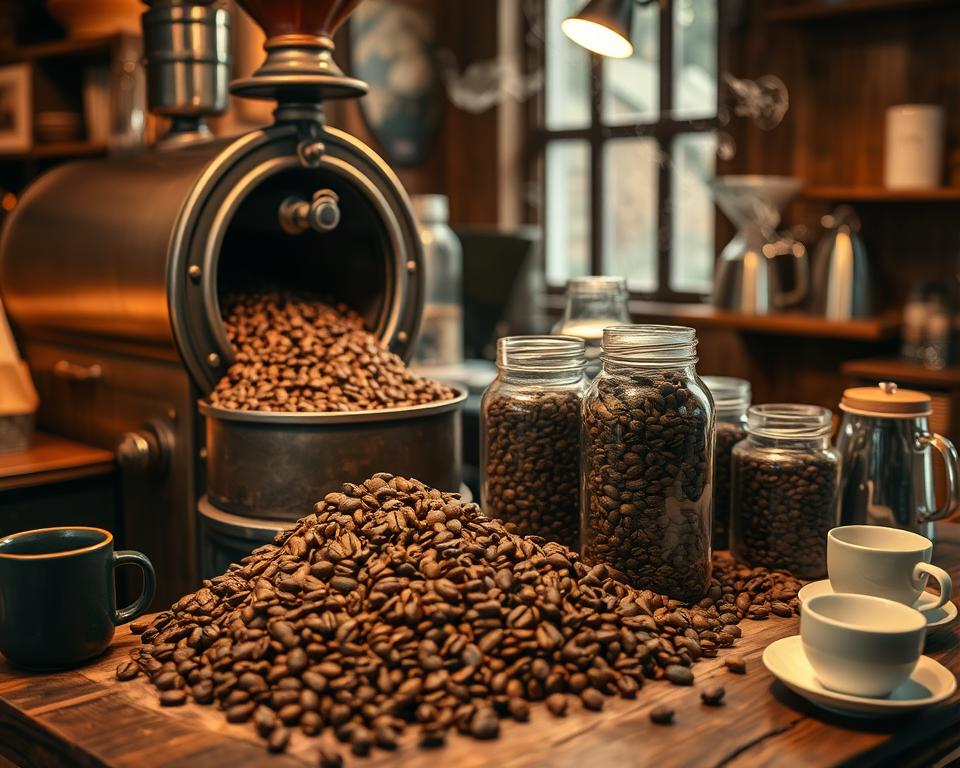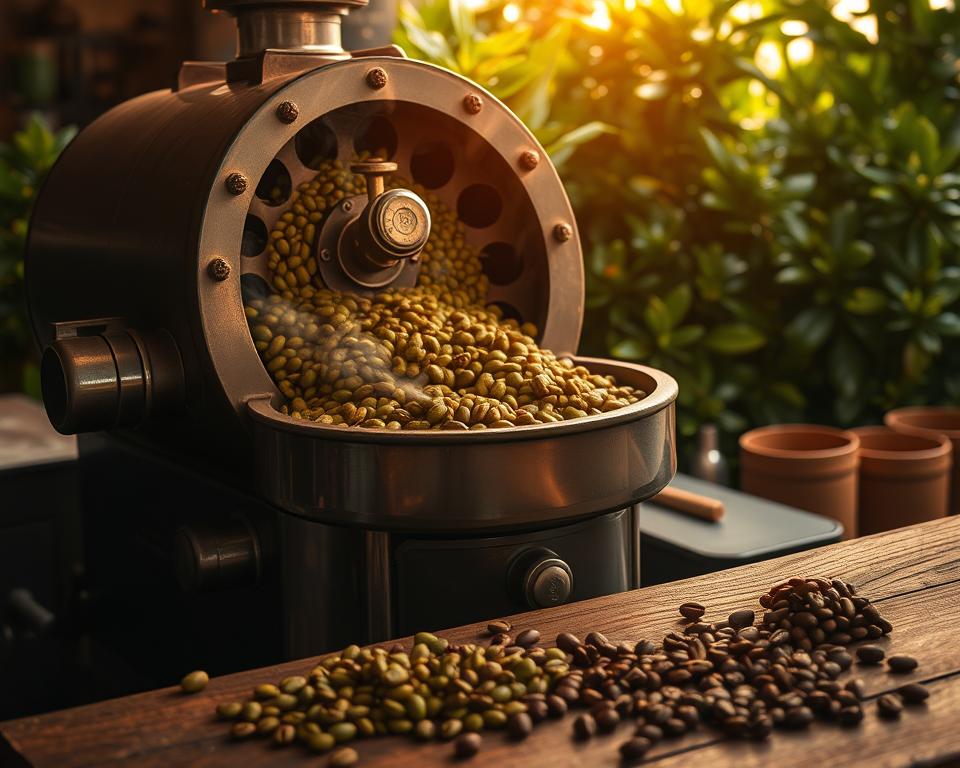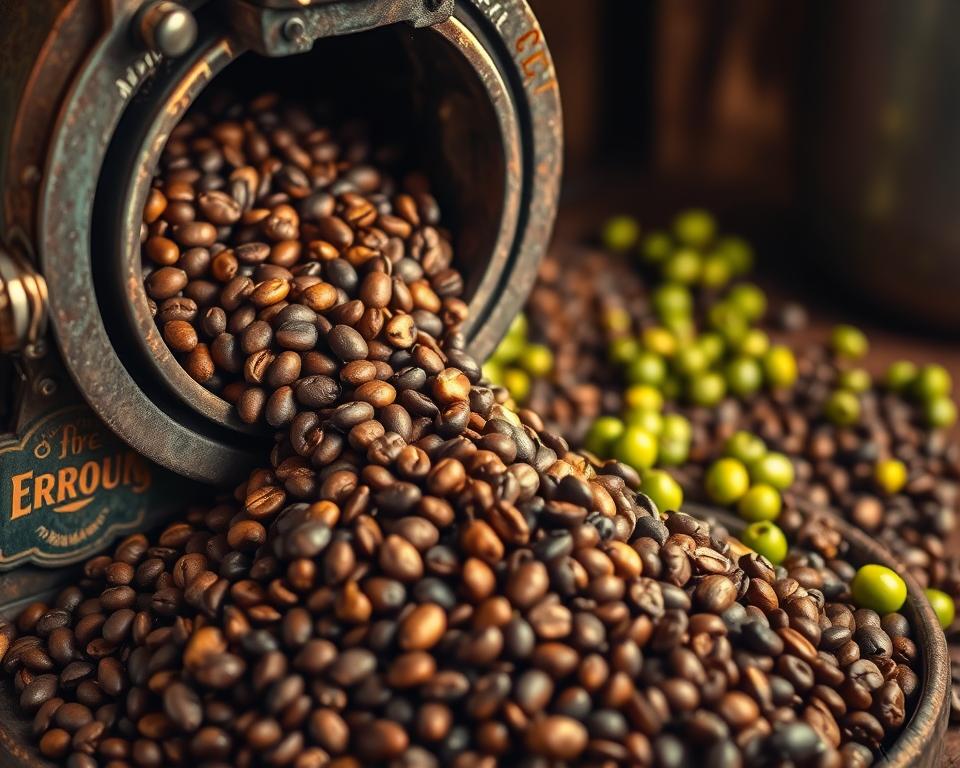Coffee roasting transforms green coffee beans into aromatic, flavorful beans, opening up a world of flavor exploration. It starts with choosing the right coffee beans and extends to the roasting process. Here, the art and science blend, showcasing the skill needed to create quality coffee.
The roasting process is intricate, with each coffee, whether blend or single origin, roasted uniquely for quality and consistency. The roasting temperature and style are adjusted to match the coffee’s specific needs. This results in distinct flavors and aromas, depending on the roast level, from light to dark.
Key Takeaways
- Coffee roasting is a combination of art and science, requiring skill to produce quality coffee.
- The roasting process involves selecting the right coffee beans and tailoring the temperature and style to achieve desired flavor profiles.
- Different roast levels, such as light, medium, and dark, offer unique flavors and aromas.
- Coffee roasting can be a complex process, with no two blends or single origin coffees being treated the same.
- The process involves continuous sensory testing to ensure the roast meets the intended flavor profile prior to packaging.
- Coffee roasting activities also involve trial and error to develop the perfect roast profile, recorded for consistency in production.
- Each batch of coffee is hand-roasted on-site, ensuring individual care for each bean variety before packaging and distribution.
What is Coffee Roasting?
Coffee roasting transforms green coffee beans into the brown beans we use for brewing. This process heats the beans to enhance aroma, flavor, and solubility. The roasting process is key to unlocking coffee’s unique flavors.
The roasting process includes several stages: drying, Maillard reaction, first crack, second crack, and carbonization. Each stage is crucial for developing coffee’s flavor and aroma. For those into home roasting, grasping these stages is vital for quality coffee production.
Here are the key stages of the roasting process:
- Drying or Yellowing: The initial stage where the beans lose moisture and turn yellow.
- Maillard Reaction: A chemical reaction that occurs when the beans are heated, resulting in the formation of new flavor compounds.
- First Crack: The stage where the beans expand and produce a popping sound, marking the transition from endothermic to exothermic reactions.
- Second Crack: The stage where the beans continue to expand and produce a louder popping sound, indicating the onset of dark roast territory.
- Carbonization: The final stage where the beans are fully roasted and have a dark brown color.
The roasting process is intricate, requiring attention to detail for quality coffee. Understanding the roasting stages allows coffee lovers to appreciate the art and science behind it. This knowledge helps in enjoying the perfect cup of coffee.
| Roast Level | Agtron Score | Description |
|---|---|---|
| Light Roast | 80-70 | Light, Cinnamon |
| Medium Roast | 70-50 | Medium, American |
| Dark Roast | 40-35 | French, Espresso |
The History of Coffee Roasting
Coffee roasting has a rich history, spanning centuries. It has evolved from raw coffee beans to the flavorful beverage we love today. This transformation has been shaped by various cultures and innovations, making it an art form. Roasters now experiment with different techniques and profiles, enriching the coffee experience.
The journey of coffee roasting is deeply connected to the evolution of coffee roasting techniques and technologies. The 17th century saw the introduction of the cylindrical coffee roaster in Cairo, Egypt. Later, the industrial revolution brought large-batch roasting machines. The 20th century’s advent of electricity in roasting enhanced safety and precision, shaping the modern coffee roasting industry.
Origins of Coffee Roasting
Coffee’s origins trace back to Ethiopia, spreading to Africa and the Middle East by the 6th century. Traditional artisanal coffee roasting methods from these regions are still cherished today. For instance, in Saudi Arabia’s Sarawat mountains, coffee is roasted over an open fire in smoky metal pans, a technique passed down through generations.
Evolution Over the Years
Over time, roasting techniques have seen significant advancements. The early 20th century’s introduction of electric coffee roasters transformed the industry, enabling mass production of high-quality roasted coffee. Today, the global coffee roasting industry offers a wide array of roasting techniques and profiles.
Some key milestones in coffee roasting’s history include:
- The first recorded coffee roasting tools emerged in the 15th century in the Ottoman Empire and Greater Persia.
- The cylindrical roaster appeared in Cairo around 1650, gaining popularity in Europe and the American colonies over the next century.
- The Arbuckle Brothers introduced the one-pound paper bag of roasted coffee in 1864, boosting commercial coffee’s popularity.
Coffee roasting has evolved significantly since its early days. Today, it’s a vibrant industry with a rich history and culture. Whether you prefer artisanal coffee or mass-produced, the essence of coffee roasting remains crucial in revealing coffee’s unique flavors and aromas.
| Century | Notable Developments |
|---|---|
| 15th | First recorded implements for roasting coffee beans |
| 17th | Cylindrical coffee roaster developed in Cairo |
| 19th | Large-batch coffee roasting machines emerged during the industrial revolution |
| 20th | Introduction of electricity to coffee roasting |
Types of Coffee Roasts
Coffee roasts are divided into three main categories: light, medium, and dark. Each roast has its own distinct flavor, roast levels, and characteristics. For those passionate about coffee beans and home roasting, understanding these differences is key.
The primary distinction among these roasts is the roasting temperature, which surpasses 400 degrees Fahrenheit. This marks the shift from light to medium roasts. Light roasts are known for their sour and acidic taste. Medium roasts offer a balanced flavor. Dark roasts, by contrast, have a deep bitterness and a shiny, oily appearance.
Light Roast
Light roast coffee beans are light brown and have a matte finish. They are roasted at a lower temperature, between 350 to 375 degrees Fahrenheit. This method helps preserve the coffee’s unique qualities. Light roasts also contain more caffeine than dark roasts.
Medium Roast
Medium roast coffee is medium brown and has a non-oily surface. It is roasted at a higher temperature than light roasts, between 410 to 425 degrees Fahrenheit. This results in a balanced flavor with a hint of caramel.
Dark Roast
Dark roast coffee beans are shiny black with an oily surface and a pronounced bitterness. Roasted at a higher temperature than medium roasts, it develops a smoky flavor. This process significantly reduces the coffee’s original flavor profile.
In home roasting, knowing the different roast types and their characteristics is vital for the perfect cup. By experimenting with various roast levels and coffee beans, enthusiasts can discover their ideal flavor. This way, they can enjoy the perfect cup of coffee.
| Roast Type | Internal Temperature | Flavor Profile |
|---|---|---|
| Light Roast | 350-375°F | Sour and acidic |
| Medium Roast | 410-425°F | Balanced and caramel-like |
| Dark Roast | 435-450°F | Smoky and bitter |
Understanding Coffee Roast Levels
Coffee roasting is an art that demands precision and patience. The roast levels significantly influence the flavor and aroma of the coffee. Artisanal coffee roasters meticulously select and roast beans to highlight each batch’s unique traits. Roast levels are categorized mainly into light, medium, and dark roasts.
The roast level profoundly impacts coffee’s taste and smell. Lighter roasts often have acidic and fruity notes, whereas darker roasts are richer and more bitter. The caffeine content also varies, with lighter roasts generally containing more. 
How Roasting Affects Flavor
The roasting process enhances the coffee beans’ unique flavors and aromas. The roast level can either accentuate or reduce specific flavor notes, depending on the bean type and roasting method. For instance, a light roast might highlight the bright, citrusy notes of Ethiopian coffee. On the other hand, a darker roast could emphasize the rich, chocolatey flavors of Brazilian coffee.
Roast Level and Aroma
The aroma of coffee is deeply connected to its roast level. Lighter roasts typically have a more delicate, floral aroma, while darker roasts offer a richer, more intense scent. The roast level also affects the coffee’s overall balance. Lighter roasts tend to be brighter and more acidic, while darker roasts are smoother and more balanced. The choice between a light and bright coffee or a rich and bold one hinges on the roast level.
Coffee Roasting Methods
Coffee roasting employs various techniques to enhance the unique flavors and aromas of coffee beans. Drum Roasting and Hot Air Roasting are the two primary methods. Drum Roasting uses conductive heat transfer, which intensifies carbohydrates and oils, resulting in a richer flavor. In contrast, Hot Air Roasting relies on convective heat transfer, producing a cleaner and sweeter taste.
Home roasting is favored by coffee aficionados for its ability to offer control over the roasting process. It allows individuals to experiment with different techniques to find their ideal flavor. Commercial roasting, done on a larger scale, uses specialized equipment to produce high-quality beans. The ideal roast time varies based on batch size and burner output, with no one-size-fits-all solution.
Home Roasting Techniques
Home roasting requires attention to temperature and time to achieve the perfect roast. The introduction of data logging software has significantly increased the learning curve for specialty roasters. Key factors in home roasting include the type of coffee beans, roast level, and the equipment used. Mastering these techniques allows individuals to enjoy a wide variety of flavors and aromas from their coffee beans.
Commercial Roasting Techniques
Commercial roasting employs specialized equipment to produce high-quality coffee beans on a large scale. Drum Roasting and Hot Air Roasting are the most common methods. Hot Air Roasting uses advanced temperature control sensors for precise temperature monitoring during roasting. Understanding these methods and techniques helps individuals appreciate the complexity and nuance of coffee roasting.
Equipment Needed for Coffee Roasting
Coffee roasting demands specific gear to achieve top-notch coffee quality. The equipment needed varies based on the operation scale, whether personal or commercial. Beginners should start with basic tools like a coffee roaster, green coffee beans, and a grinder.
The right coffee roasting equipment significantly impacts the final product’s quality. Roasting equipment spans from small, manual roasters to large, commercial machines. For novices, it’s vital to select equipment that’s user-friendly and easy to maintain.
Essential Tools for Beginners
Beginners need a few key tools:
- Coffee roaster: This is the most critical piece of equipment for coffee roasting. It can be a manual or automatic roaster, depending on the user’s preference.
- Green coffee beans: These are the raw beans that will be roasted to produce the final product.
- Grinder: A grinder is necessary to grind the roasted beans into a fine powder for brewing.
Advanced Equipment for Professionals
Commercial coffee roasters require advanced equipment to produce large quantities of high-quality coffee. This includes:
| Equipment | Description |
|---|---|
| Coffee bean analyzer | Used to assess the quality of the green coffee beans |
| Moisture-density analyzer | Used to measure the moisture content of the beans |
| High-capacity shop grinders | Used to grind large quantities of coffee beans |
How to Choose the Right Green Coffee Beans
Choosing the right green coffee beans is essential for home roasting to achieve the perfect flavor. With numerous options, selecting the right beans can be daunting. Yet, by focusing on a few key factors, you can make a well-informed choice. This will lead to a delicious cup of coffee.
Key factors include the origin, variety, and processing method of the beans. The origin significantly influences the flavor, with different regions offering unique taste profiles. The variety also plays a role, with some being more prone to certain flavor notes. The processing method, whether natural or washed, further impacts the flavor and quality.
Here are some factors to consider when choosing green coffee beans:
- Origin: Consider the region and country of origin, as this can impact the flavor profile.
- Variety: Choose a variety that is known for its flavor profile and quality.
- Processing method: Decide between natural and washed processing methods, depending on your flavor preferences.
By considering these factors and doing your research, you can select the right green coffee beans for your home roasting needs. This will ensure a delicious cup of coffee.
| Origin | Variety | Processing Method |
|---|---|---|
| Kenya | Arabica | Natural |
| Colombia | Robusta | Washed |
The Science Behind Coffee Roasting
Coffee roasting is a complex process that involves a series of chemical changes. These changes occur when green coffee beans are heated. The roasting process can be divided into several stages, each with its own unique characteristics. Understanding the science behind coffee roasting is crucial for producing high-quality, artisanal coffee.
During the roasting process, the beans undergo a series of physical and chemical changes. The Maillard reaction occurs when the beans are heated to around 302°F (150°C). This reaction is responsible for the development of the coffee’s flavor and aroma. The coffee roasting process also involves the caramelization of sugars, which occurs when the beans are heated to high temperatures.

The ideal roasting process involves a steadily decreasing Rate of Rise (RoR) throughout the roasting process. This helps to avoid undesirable outcomes, such as “baked coffee” or “scorched coffee.” By understanding the science behind coffee roasting, coffee roasters can produce high-quality, artisanal coffee that is full of flavor and aroma.
Tips for Perfecting Your Coffee Roast
Coffee roasting is an art that demands patience and practice. Understanding the various roast levels is key. Each level, from light to dark, brings a unique flavor. For those into home roasting, experimenting with roast levels is crucial to discover the ideal taste.
To nail the perfect roast, start with a coffee roasting basics guide. Adjust the time and temperature as needed. Some prefer lighter roasts, while others enjoy darker ones. The goal is to strike a balance between flavor and acidity.
Here are some tips for perfecting your coffee roast:
- Experiment with different roast levels to find the perfect flavor
- Adjust the time and temperature to achieve the desired roast level
- Use high-quality coffee beans to ensure the best flavor
By following these tips and practicing patience, you can perfect your coffee roast. Enjoying the perfect cup of coffee becomes a regular occurrence. Whether you’re an experienced roaster or a beginner, the secret to success lies in experimentation and adjusting your techniques.
Exploring Coffee Roasting Communities
Embarking on the journey of coffee roasting opens doors to a world of like-minded individuals and experts. Whether you’re just starting or have years of experience, diving into the coffee roasting community can be transformative. It’s a chance to learn, share, and grow with others who share your passion.
Online Forums and Resources
The digital age has revolutionized access to knowledge and support. Online forums, like Home-Barista, serve as hubs for roasters to exchange experiences, seek advice, and learn from each other. These platforms are treasure troves of information, covering everything from green coffee beans to advanced roasting techniques. They help you hone your skills and keep abreast of industry advancements.
Joining Local Coffee Clubs
Offline, joining a local coffee club or roasting collective offers unique benefits. These groups host educational events, cupping sessions, and networking opportunities. They provide a space to connect with artisanal coffee aficionados in your community. Through these interactions, you can gain invaluable insights, explore new roasting methods, and even embark on collaborative projects.
FAQ
What is coffee roasting and why is it important?
What are the different stages of the coffee roasting process?
How has coffee roasting evolved over the years?
What are the different types of coffee roasts?
How does the roast level affect the flavor of coffee?
What are the different coffee roasting methods?
What equipment is needed for coffee roasting?
How do I choose the right green coffee beans?
What is the science behind coffee roasting?
How can I perfect my coffee roast?
Where can I find coffee roasting communities?

Paul Allen is a writer at WyNeeds, a website dedicated to the world of coffee. Passionate about aromas and flavors, he explores everything from the best brewing methods to fascinating insights about coffee beans and industry trends. His goal is to provide readers with engaging and informative content, helping both beginners and coffee enthusiasts deepen their knowledge of the world’s most beloved beverage.

